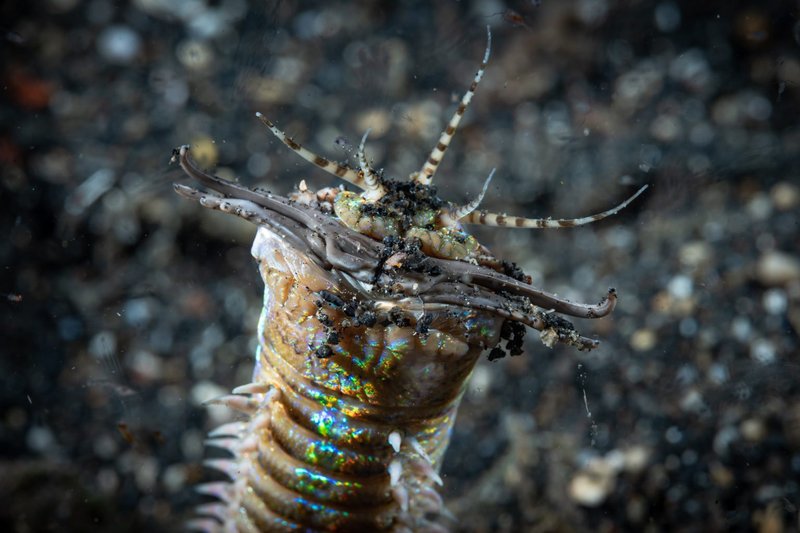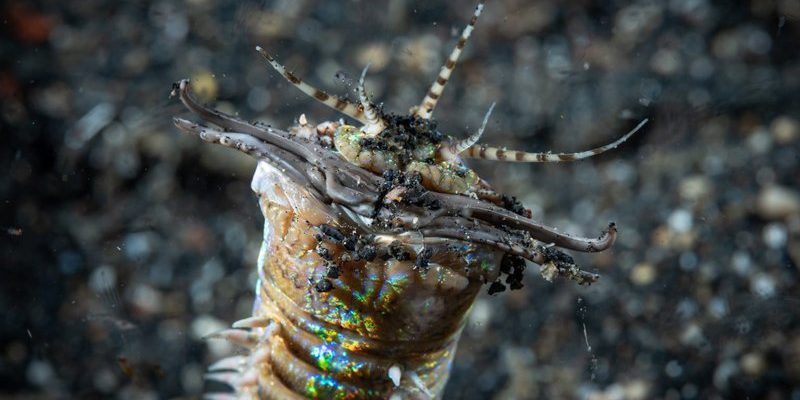
Let’s think of it like a neighborhood. You’ve got the mysterious, solitary bobbit worm, living in its burrow, and then there’s the busy cleaner shrimp, darting about offering spa services to fish. Just like some neighbors might get along famously, while others might clash, the dynamics in your aquarium can be quite similar. Understanding their behaviors and needs can help you make an informed decision about whether to house these two together.
Understanding Bobbit Worms
Bobbit worms, known scientifically as *Eunice aphroditois*, are marine predators that can reach impressive lengths—up to three feet or more. They’re named after the infamous Lorena Bobbitt, not because they snip things off, but due to their swift, often surprising attacks. These worms remain hidden within their burrows, using their long, segmented bodies to ambush unsuspecting prey that swims by.
Their diet primarily consists of small fish and crustaceans. Picture this: you’re at a restaurant, and before you know it, a hungry bobbit worm has swiped your appetizer! This predator’s ambush tactic makes it critical to understand its impact on the tank’s ecosystem. If you’re planning to keep bobbit worms, remember they can be aggressive and territorial, which might not sit well with smaller, more vulnerable tank mates.
Meet the Cleaner Shrimp
On the flip side, we have cleaner shrimp, particularly those from the *Lysmata* genus, like the popular *cleaner shrimp* (*Lysmata amboinensis*). These little guys are known for their vibrant colors and social behavior. They busily hop from fish to fish, cleaning off dead skin and parasites, much like a friendly neighborhood barber.
Cleaner shrimp are not just helpful; they play an essential role in maintaining tank health. They help keep fish happy and healthy, creating a cleaner environment. You might think of them as the *good guys* of the reef! But here’s the catch: while they’re helpful, their small size (typically 1.5 to 2 inches long) makes them vulnerable to larger predators, which brings us back to the bobbit worm.
Can They Coexist? Factors to Consider
So, can bobbit worms and cleaner shrimp live harmoniously? The answer largely depends on your tank setup and the individual personalities of the creatures involved. A few key factors to weigh include:
- Tank Size: A larger tank gives the bobbit worm enough space to claim its territory while providing the cleaner shrimp room to scuttle about.
- Hiding Spots: Lots of rocks and caves offer cleaner shrimp places to hide. This can be a crucial lifeline against the bobbit worm’s hunting tactics.
- Feeding Habits: If you’re feeding the bobbit worm a well-balanced diet, it might be less inclined to hunt the cleaner shrimp.
Here’s the thing: if your tank is well-planned and you keep the shrimp busy with regular meals, they might just avoid the attention of the worm. However, always keep an eye on their interactions, as individual personalities can play a huge role in their coexistence.
Potential Risks of Keeping Them Together
While it’s possible for bobbit worms and cleaner shrimp to share a tank, there are inherent risks. Bobbit worms are natural predators, and their instincts can be hard to ignore. In a smaller tank, those instincts might lead to unfortunate events where the worm sees the cleaner shrimp as a potential snack.
Additionally, bobbit worms can be quite territorial. If they feel their space is being encroached upon, they may be more likely to attack not just shrimp, but any fish that wanders too close. If you’re set on keeping both species, here are a few cautionary steps:
- Monitor Behavior: Keep an eye on the interactions. If you notice aggression, be ready to intervene.
- Provide Plenty of Space: The more room they have, the less likely they are to cross each other’s paths.
- Be Prepared to Separate: If things go south, always have a backup plan to separate the species before any serious harm occurs.
Best Practices for Keeping Both Species
If you decide to move forward with keeping both bobbit worms and cleaner shrimp, there are some best practices to ensure everyone stays safe and healthy.
First, **feed your bobbit worm regularly**. A well-fed worm is a less aggressive worm. Consider a diet of chopped fish or shrimp pellets to satiate its appetite. Secondly, ensure your tank is equipped with **lots of hiding spots**. Rock formations, caves, and dense plants can give cleaner shrimp safe havens from the worm’s predatory gaze.
Lastly, **observe your tank regularly**. Regular checks can help you catch any aggressive behavior early. Remember, aquariums are dynamic ecosystems, and what works one week may change the next. Being proactive can save you a lot of heartache.
Alternatives to Consider
If the idea of bobbit worms and cleaner shrimp sharing the same environment feels too risky, there are plenty of alternatives to consider. Some fish species, like clownfish or wrasses, can play the role of cleaning agents without the vulnerabilities of cleaner shrimp.
Alternatively, you could explore other shrimp species that are sturdier and less likely to provoke the bobbit worm. **Peppermint shrimp** or **fire shrimp** can sometimes coexist more peacefully with potential predators.
Remember, every aquarium is unique. What works for one setup might not work for another. Always do your research and consider the specific needs and behaviors of any species you want to combine.
In conclusion, bobbit worms and cleaner shrimp can potentially coexist, but it requires careful planning and attention. Understanding their behaviors, feeding needs, and the dynamics of your tank is crucial. Always prioritize the well-being of your aquatic friends.
If you’re ready to take the plunge, prepare your tank thoughtfully and keep a close eye on their interactions. With a bit of luck and management, you might just find a way to enjoy the beauty and eccentricity of both species in your underwater world.
Happy aquascaping!

